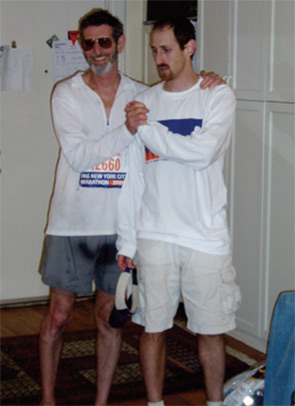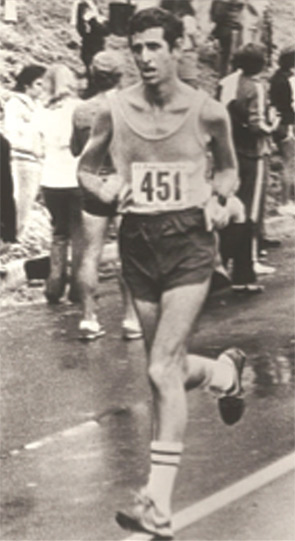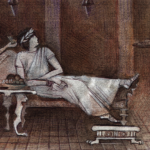
Run for Your Life
Exercise is good for you. Those clichéd jokes about feeling the urge to exercise and then lying down until it passed are tired. The literature is replete with good evidence that regular exercise is salutary for cardiovascular disease (ischemic heart disease, strokes, and blood pressure), psychological and emotional well being, weight control and obesity, noninsulin-dependent diabetes, disability, longevity, osteoporosis, anxiety and depression, and probably cognition and certain cancers.
There’s also good evidence now—accumulated by Jim Fries, Nancy Lane, their colleagues, and me and my colleagues—that running and most recreational exercise does not necessarily lead to osteoarthritis; indeed, reasonable exercise programs are probably good not only for healthy joints but also for certain patients with joint disease.

I’ve been running for nearly four decades. Despite intermittent injuries, I enjoy it and try to complete a marathon each year. In my younger days I raced (see photo at right), but without much competitive success. (My youngest son, David, took up running seriously, was on his high school state championship and collegiate [Williams] NCAA national champion cross-country teams, held school distance records, and now coaches; he must have my wife’s genes.) I looked forward to the day we could go for runs together, when he said “Dad, I’m not a recreational runner, I’m an athlete; besides I can’t run as slow as you do.” We did run the New York City Marathon (his only marathon) “together”— that is, we started together and finished separately—a couple years ago. He was humbled and didn’t quite surpass my best marathon time. My middle son and daughter run casually, sometimes with me, and my dogs run with me. My wife tried running, disliked it, and walks pretty regularly. My latest injury is unilateral buttock pain, which at times is very limiting. It doesn’t seem to be radicular, neurologic, or boney; it is perhaps biomechanical-related muscle (gluteal, pyriformis) tightness/spasm/dysfunction, but it does not respond to anything (e.g., physical therapy, modalities, or medication) except local injections and not running. I welcome any helpful thoughts or suggestions.
Why, or how, then is exercise healthy? What’s the mechanism? There was an interesting report examining the “molecular” signature of exercise.1 Investigators at Massachusetts General Hospital in Boston used targeted liquid chromotagraphy–mass spectrometry (LC-MS) to examine metabolic changes in plasma in response to exercise and to further determine whether metabolites modulated expression of transcriptional regulators. They found enormous changes in plasma indicators of glycogenolysis (glucose-6-phosphate), TCA cycle span 2 expansion (succinate, malate, and fumarate), and lipolysis (glycerol), as well as modulators of insulin sensitivity (niacinamide) and fatty acid oxidation (pantothenic acid) following acute exercise (10 minutes on a treadmill or bicycle and Boston marathon finishers). The changes correlated with fitness. A combination of these metabolites (glycerol, niacinamide, glucose-6-phosphate, pantothenate, and succinate) upregulated in vitro expression of a transcriptional regulator of glucose utilization and lipid metabolism genes in rodent skeletal muscle. These data suggested that exercise led cells to release metabolites that can act on genes regulating glucose and lipid metabolism. Maybe that’s why exercise is good.

On Horseshoes and Hand Grenades
When they were younger, my children used to joke that it was OK for some things if you were just “close,” that it wasn’t necessary to be precise about everything. The analogy was that such things were like playing horseshoes or setting off hand grenades.
I used to believe that was case for joint injections. There is literature that shows that only about 52% of injections, almost regardless of injectors’ expertise and training, could be documented to be intraarticular—66% for knees, 83% for elbows, 10% for shoulders, 50% for wrists, and none in carpal metacarpal, metacarpophalangeals, interphalangeals, or acromioclavicular joints.
I was nonplussed by this. I thought we did better—I certainly thought I did (and I don’t know that I don’t!). This could be improved by imaging and by air arthrography.2,3 So, would ultrasound-guided injections be better and, perhaps more importantly, would it matter therapeutically?
My new colleague, Karina Torralba, with expertise in musculoskeletal ultrasound, sees ultrasound as enhancing the physician exam (reminding us of or teaching us the relevant anatomy, which informs the exam), as offering important diagnostic information (early rheumatoid arthritis, soft tissue disorders, and other situations), helping us follow outcomes for some clinical conditions, perhaps assisting us therapeutically (grading synovitis, for example), and providing educational value in simulations (for fellows and others). I expect to learn more from her.
A recent report found that ultrasound indeed improved accuracy of injections, but interestingly could not show that outcomes from therapeutic injections were better.4 Maybe my kids were right.
Is Amyloid an Infectious Disease?
It could be, according to an article in Science.5 Despite the old precept of being wary of publications that have almost as many authors as data or subjects, this was a provocative study. Mouse brain lysates containing aggregates of amyloid beta peptide injected intraperitoneally into naive recipients caused plaque-associated pathological changes in brains. Why similar inoculations by intracerebral, intravenous, oral, intraocular, or intranasal routes failed to induce disease was unclear and certainly requires that the experiments be confirmed. The pathologic mechanism was reminiscent of prion transmission. This has implications for therapeutic strategies (attempts to block protein transmission) including a cautionary note for stem cell–based approaches.
These data suggested that exercise led cells to release metabolites that can act on genes regulating glucose and lipid metabolism. Maybe that’s why exercise is good.
Dr. Panush is professor of medicine, division of rheumatology, department of medicine, Keck School of Medicine, University of Southern California in Los Angeles.
References
- Lewis GD, Farrell L, Wood MJ, et al. Metabolic signature of exercise in human plasma. Science Translational Medicine. 2010. 2:33ra37.
- Sergent JS, ed. Yearbook of Rheumatology. 1995, pp 317-318.
- Panush RS, ed. Yearbook of Rheumatology. 2002, pp 58-59.
- Cunnington J, Marshall N, Hide G, et al. A randomized, double-blind, controlled study of ultrasound-guided corticosteroid injection into the joint of patients with inflammatory arthritis. Arthritis Rheum. 2010;63:1862-1869.
- Eisele YS, Obermuller U, Hellbronner G, et al. Peripherally applied Abeta-containing inoculates induce cerebral beta-amyloidosis. Science. 2010;330:980-982.
